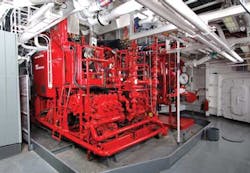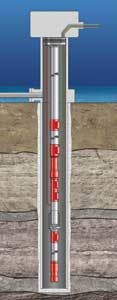The Shell Perdido project represents an industry milestone in overcoming the technology challenges of ultra-deep waters, subsalt drilling, and complex completions under extreme downhole conditions. Halliburton has been associated with Shell’s deepwater Gulf of Mexico projects since the Cognac field in 1979 and has been an integral part of the Perdido successes since its earliest phases, providing drilling, cementing, permanent monitoring, and chemical injection solutions.
Comprehensive Drilling Services
Halliburton’s involvement in the Perdido project began in 1999 during the early exploration of the Great White field. In 2006, Halliburton began drilling “batch-set” wells for the Perdido spar, providing Sperry performance mud motors and basic LWD services. Subsequently, Halliburton deepened some of the batch- set wells and used the Geo-Pilot® rotary steerable system with the GeoTap® LWD formation tester to help evaluate the compartmentalized formations in real time. Halliburton also drilled horizontal wells in the Silvertip field using all the basic services plus StrataSteer® 3D Geosteering Service and InSite ADR™ Azimuthal Deep Resistivity Sensor to optimize wellbore placement. This stage of the project was completed in October 2009. Based on the value Shell and the Perdido team gained from the application of these advanced technologies and enhanced personnel experience, Halliburton was awarded subsequent drilling services work for the spar and subsea wells. Drilling for the infield subsea wells will begin in April 2010 and drilling for spar should begin in June.
Cementing Services with Zero NPT
Halliburton completed Shell’s batch-set project within the specified time window, delivering maximum efficiency without sacrificing quality. This included the installation on the rig of a steady flow bin, continuous metering system,150-bbl batch mixer and Halliburton’s state-of-the-art HCS Advantage™ cementing skid for cementing operations and well control contingencies.
Halliburton used two-man crew teams to ensure continuous cementing operations with coordination through its facility in Alaminos Canyon. The key to helping improve the probability of getting cement slurry to seabed was the ZoneSeal® Isolation Process, an automated control system for foam cementing services. By using a fully automated nitrogen unit, the cementing crew was able to foam the standard Type-1 cement before injection of the unfoamed tail slurry. For some wells, the spacer was also foamed to increase the sweeping efficiency, reducing hydrostatic pressure and assisting successful placement of foamed lead and conventional tail slurry. On inner-string cementing jobs, a drill pipe dart was released and latched into the float shoe to help address cement slurry residue/contamination on the walls of the drill pipe. In total, Halliburton batch-set 23 wells by mixing and pumping 96,000 sacks of cement in an offshore environment of over 8,500-ft water depth. In all, this was a very successful cementing operation with zero NPT related to the cementing operations.
Permanent Monitoring and Chemical Injection
Halliburton WellDynamics has supplied Shell with permanent monitoring and chemical injection systems for their subsea installations since the mid-1990s. Due to the reliability and success of these previous installations, Halliburton won the contract to supply the permanent monitoring and chemical injection systems for the Perdido project.
Conventional subsea completions, which are to be completed from both the Perdido spar and mobile offshore drilling units, consist of 20 Kpsi ROC™ series dual-quartz gauge assemblies, shallow and deep-set chemical injection systems, and multi-line spooling services. All equipment was manufactured to meet Shell’s specific material requirements for the Perdido project. As part of the systems approach to the installation of permanent monitoring systems, Halliburton WellDynamics also supplied and installed the electrical feed-through systems for the FMC direct vertical access subsea wellhead systems. This was the first installation of this feed-through system design in the Gulf of Mexico and the installation process ensured that multiple checks were carried out on the wellhead systems between installation and subsea deployment to confirm they were fit for purpose. The first successful subsea installation on a satellite subsea well was completed in October 2008 and the equipment installed is designed to supply downhole pressure and temperature data for the life of the wells.
Since the Perdido project has low energy reservoirs, subsea separating and boosting systems (SBS) are installed on the Perdido Spar to lift the hydrocarbons to the surface. As part of this SBS system, Halliburton WellDynamics installed three specially calibrated ROC series gauges in the lower completion to allow real-time measurements of fluid levels. These fluid measurements are used to ensure optimum fluid levels at the electrical submersible pump (ESP), and therefore, extend the life of operation before a workover is required. Along with the fluid level measurements, Halliburton WellDynamics supplied multiple chemical injection systems and multi-line spooling services. During the first two SBS installations, changes were made to the installation process and equipment resulting in a substantial reduction in the installation time of the systems. Plans are to provide additional subsea installations and SBS systems.
Halliburton WellDynamics SBS Level Monitoring System
Continued Commitment
Halliburton will continue to provide the full extent of oilfield services for the Perdido project through all its phases and is Shell’s willing partner as we extend the search for oil and gas to future frontiers in the Gulf of Mexico and around the world.
Halliburton
10200 Bellaire Blvd., Houston, TX 77072
Tel: 281.575.3000
Website: www.halliburton.com






